Driving Forces of Ecosystem Transformation in Extremely Arid Areas: Insights from Hami City in Xinjiang, China
Abstract
1. Introduction
2. Materials and Methods
2.1. Study Area
2.2. Data Sources
2.3. Research Methods and Technology Roadmap
2.3.1. Ecosystem Pattern
2.3.2. Ecosystem Quality
- Fractional Vegetation Cover
- 2.
- Net Primary Productivity
2.3.3. Ecosystem Services
- Soil Retention
- 2.
- Windbreak and Sand Fixation
2.3.4. Ecosystem Change Assessment
- Spatiotemporal Variation Trend
- 2.
- Degree of Change
2.3.5. Analysis of Driving Forces of Ecosystem Change
3. Results and Analysis
3.1. Spatiotemporal Variation in Ecosystems
3.1.1. Macroscopic Structural Changes in Ecosystems
3.1.2. Spatiotemporal Variation in Ecosystem Quality
3.1.3. Spatiotemporal Variation in Ecosystem Services
3.2. Analysis of Ecosystem Change Trends and Degrees
Degree of Ecosystem Change and Spatial Differences
3.3. Factors Influencing the Degree of Ecosystem Change
4. Discussion
5. Conclusions
- From 2000 to 2023, the ecosystem pattern in Hami City changed significantly, mainly reflected by the expansion of the cropland ecosystem, grassland ecosystem, and urban ecosystem, along with a reduction in the desert ecosystem. Among these, the urban ecosystem increased the most.
- From 2000 to 2023, FVC, NPP, and G in Hami City showed an increasing temporal trend, while SC showed a decreasing trend. Spatially, FVC exhibited a relatively slow overall change. NPP showed an increase in the central core area and a decrease in the surrounding central area. The central area of SC showed a decreasing trend. The southeastern region of G decreased significantly.
- Overall, the ecosystem change in Hami City was at a moderate level. Areas with a moderate level of change were mainly distributed in the southwestern and southeastern parts of the city. Areas with a good level were primarily located in the northern and central regions, while areas with a poor level were mainly distributed in the northern, central, and southeastern parts of Hami City.
- Ecological fundamental factors such as temperature, precipitation, and evapotranspiration were the most important driving forces of ecosystem change in Hami City. Among these, the rate of temperature change was the most critical driver. The rates of change in evapotranspiration, precipitation, soil moisture, and GDP also played key roles in determining the degree of ecosystem change in Hami City.
- Future studies should explore the presence and ecological role of gravel layers, which may help reduce wind erosion and conserve soil moisture, and investigate the interactions among ecosystem driving forces. The indicator framework developed here should be tested in other arid regions to improve its applicability. Strategies for mitigating or adapting to climate change must be implemented promptly to ensure the sustainable development of ecosystems in arid regions.
Author Contributions
Funding
Data Availability Statement
Conflicts of Interest
Abbreviations
| CE | Cropland Ecosystem |
| DE | Desert Ecosystem |
| DEM | Digital Elevation Model |
| EI | ecological index |
| ET_RA | Annual mean rate of total evapotranspiration change |
| FE | Forest Ecosystem |
| FVC | Fractional Vegetation Cover |
| G | Gross weight of annual windbreak and sand fixation per unit area |
| GE | Grassland Ecosystem |
| GDP | Gross Domestic Product |
| GDP_GR | Annual mean GDP growth rate |
| LUCC | Land Use and Cover Change |
| MAP | Mean Annual Precipitation |
| MIN_RA | Annual mean rate of mining area change |
| NPP | Net Primary Productivity |
| POP_GR | Annual mean population growth rate |
| PRE_RA | Annual mean rate of precipitation change |
| RMSE | Root Mean Squared Error |
| RUSLE | Revised Universal Soil Loss Equation |
| RWEQ | Revised Wind Erosion Equation |
| SC | Soil retention capacity |
| SM_RA | Annual mean rate of soil moisture change |
| TEM_RA | Annual mean rate of temperature change |
| UE | Urban Ecosystem |
| WE | Wetland Ecosystem |
References
- DeFries, R.S.; Foley, J.A.; Asner, G.P. Land-use choices: Balancing human needs and ecosystem function. Front. Ecol. Environ. 2004, 2, 249–257. [Google Scholar] [CrossRef]
- Paruelo, J.; Burke, I.; Lauenroth, W. Land-use impact on ecosystem functioning in eastern Colorado, USA. Glob. Change Biol. 2001, 7, 631–639. [Google Scholar]
- Foley, J.A.; DeFries, R.; Asner, G.P.; Barford, C.; Bonan, G.; Carpenter, S.R.; Chapin, F.S.; Coe, M.T.; Daily, G.C.; Gibbs, H.K. Global consequences of land use. Science 2005, 309, 570–574. [Google Scholar] [CrossRef] [PubMed]
- MacDonald, A.J.; Larsen, A.E.; Plantinga, A.J. Missing the people for the trees: Identifying coupled natural–human system feedbacks driving the ecology of Lyme disease. J. Appl. Ecol. 2019, 56, 354–364. [Google Scholar]
- Runting, R.K.; Bryan, B.A.; Dee, L.E.; Maseyk, F.J.; Mandle, L.; Hamel, P.; Wilson, K.A.; Yetka, K.; Possingham, H.P.; Rhodes, J.R. Incorporating climate change into ecosystem service assessments and decisions: A review. Glob. Change Biol. 2017, 23, 28–41. [Google Scholar]
- Xiao, F.; Ouyang, H.; Cheng, S.; Zhang, Q. Forest health ecological risk assessment in China. Ying Yong Sheng Tai Xue Bao = J. Appl. Ecol. 2004, 15, 349–353. [Google Scholar]
- Han, J.; Sun, Y.; Yang, F. Assessing drought risk of grassland ecosystem in Hulunbuir, China. Ecol. Indic. 2025, 175, 113522. [Google Scholar] [CrossRef]
- Jia, B.; Zhang, Z.; Ci, L.; Ren, Y.; Pan, B.; Zhang, Z. Oasis land-use dynamics and its influence on the oasis environment in Xinjiang, China. J. Arid. Environ. 2004, 56, 11–26. [Google Scholar] [CrossRef]
- Zhang, X.; Wu, T.; Du, Q.; Ouyang, N.; Nie, W.; Liu, Y.; Gou, P.; Li, G. Spatiotemporal changes of ecosystem health and the impact of its driving factors on the Loess Plateau in China. Ecol. Indic. 2025, 170, 113020. [Google Scholar]
- Fu, B.; Liu, Y.; Lü, Y.; He, C.; Zeng, Y.; Wu, B. Assessing the soil erosion control service of ecosystems change in the Loess Plateau of China. Ecol. Complex. 2011, 8, 284–293. [Google Scholar] [CrossRef]
- Wang, C.; Qiu, X.; Shen, H.; Rao, C. Evaluation mechanism of urban green competitiveness via a gray fuzzy comprehensive evaluation model. Ecol. Indic. 2025, 175, 113510. [Google Scholar] [CrossRef]
- Wang, D.; Zheng, J.; Song, X.; Ma, G.; Liu, Y. Assessing industrial ecosystem vulnerability in the coal mining area under economic fluctuations. J. Clean. Prod. 2017, 142, 4019–4031. [Google Scholar] [CrossRef]
- Li, M.; Liu, S.; Wang, F.; Liu, H.; Liu, Y.; Wang, Q. Costbenefit analysis of ecological restoration based on land use scenario simulation and ecosystem service on the Qinghai-Tibet Plateau. Glob. Ecol. Conserv. 2006, 34, 2022. [Google Scholar]
- Sui, X.; Sun, Y.; Wang, X.; Yuan, J. Research on ecological quality and restoration of fragile mining areas in the Yellow River Basin—The case of Xiegou coal mine. Ecol. Indic. 2025, 174, 113426. [Google Scholar] [CrossRef]
- Pullen, A.; Kapp, P.; Chen, N. Development of stratigraphically controlled, eolian-modified unconsolidated gravel surfaces and yardang fields in the wind-eroded Hami Basin, northwestern China. Bulletin 2018, 130, 630–648. [Google Scholar] [CrossRef]
- Hansen, M.; Song, X.-P. Vegetation Continuous Fields (VCF) Yearly Global 0.05 deg. 2018. Available online: https://doi.org/10.5067/MEaSUREs/VCF/VCF5KYR.001 (accessed on 11 November 2024).
- Running, S.; Zhao, M. MYD17A3HGF MODIS/Aqua Net Primary Production Gap-Filled Yearly L4 Global 500 m SIN Grid V006. 2019. Available online: https://doi.org/10.5067/MODIS/MYD17A3HGF.006 (accessed on 12 November 2024).
- Li, X.; Mao, D.; Xue, J.; Wang, S.; Chang, J.; Liu, X. Integrative assessment and management implications on loss of ecosystem services value of desert-oasis ecotone due to artificial oasis expansion. Glob. Ecol. Conserv. 2025, 58, e03450. [Google Scholar] [CrossRef]
- Guo, X.; Shao, Q.; Yang, F.; Liu, G.; Liu, S.; Zhang, X. Assessing the restoration status and potential of ecosystem services on the Loess Plateau. Ecol. Indic. 2022, 141, 109103. [Google Scholar] [CrossRef]
- Munson, S.; Bradford, J.; Hultine, K.R. An integrative ecological drought framework to span plant stress to ecosystem transformation. Ecosystems 2021, 24, 739–754. [Google Scholar] [CrossRef]
- Liu, H.; Gong, P.; Wang, J.; Clinton, N.; Bai, Y.; Liang, S. Annual dynamics of global land cover and its long-term changes from 1982 to 2015. Earth Syst. Sci. Data 2020, 12, 1217–1243. [Google Scholar] [CrossRef]
- Song, X.-P.; Hansen, M.C.; Stehman, S.V.; Potapov, P.V.; Tyukavina, A.; Vermote, E.F.; Townshend, J.R. Global land change from 1982 to 2016. Nature 2018, 560, 639–643. [Google Scholar] [CrossRef] [PubMed]
- Bakker, M.M.; Govers, G.; Kosmas, C.; Vanacker, V.; Van Oost, K.; Rounsevell, M. Soil erosion as a driver of land-use change. Agric. Ecosyst. Environ. 2005, 105, 467–481. [Google Scholar] [CrossRef]
- Zhang, H.; Fan, J.; Cao, W.; Harris, W.; Li, Y.; Chi, W.; Wang, S. Response of wind erosion dynamics to climate change and human activity in Inner Mongolia, China during 1990 to 2015. Sci. Total Environ. 2018, 639, 1038–1050. [Google Scholar] [PubMed]
- Zhang, B.; Cao, J.; Chen, D.; Li, X.; Liu, Y.; Wang, J.; Liu, T. Construction of watershed ecological security patterns with integrated of spatial variability: A case study of the Yellow River Basin, China. Ecol. Indic. 2024, 159, 111663. [Google Scholar] [CrossRef]
- Zhang, K.; Zhang, H.; An, Z.; Xue, C. Evaluation of windproof and sand fixation effect of protective system in the Desert oasis ecotone of Mingsha Mountain Dunhuang. Sci. Rep. 2025, 15, 546. [Google Scholar] [CrossRef]
- Cai, C.; Ding, S. Study of applying USLE and geographical information system IDRISI to predict soil erosion in small watershed. J. Soil Water Conserv. 2000, 2, 19–24. [Google Scholar]
- Wischmeier, W.H.; Smith, D.D. Predicting Rainfall Erosion Losses: A Guide to Conservation Planning; Department of Agriculture, Science and Education Administration: Washington, DC, USA, 1978. [Google Scholar]
- Williams, J.; Renard, K.; Dyke, P. A new method for assessing erosion’s effects on soil productivity. J. Soil Water Conserv. 1983, 38, 381–383. [Google Scholar] [CrossRef]
- Sun, L.; Liu, F.; Zhu, X.; Zhang, G. High-resolution digital mapping of soil erodibility in China. Geoderma 2024, 444, 116853. [Google Scholar] [CrossRef]
- Mao, L.; Mo, D.; Guo, Y.; Fu, Q.; Yang, J.; Jia, Y. Multivariate analysis of heavy metals in surface sediments from lower reaches of the Xiangjiang River, southern China. Environ. Earth Sci. 2013, 69, 765–771. [Google Scholar]
- Arong, L.; Dongmei, Z.; Jing, M.; Xiaoyan, Z.; Jing, J.; Jun, Z. Evaluation of wind prevention and sand fixation function in Shule River Basin based on RWEQ model. Arid Land Geogr. 2024, 47, 58–67. [Google Scholar]
- Jiang, L.; Xiao, Y.; Rao, E.; Wang, L.; Ouyang, Z. Effects of land use and cover change (LUCC) on ecosystem sand fixing service in Inner Mongolia. Acta Ecol. Sin. 2016, 36, 3734–3747. [Google Scholar]
- Smith, F.B.; Carson, D.J. Some thoughts on the specification of the boundary-layer relevant to numerical modeling. Bound. LayerMeteorology 1977, 12, 307–330. [Google Scholar]
- Zhang, H.; Gao, Y.; Cui, Y. Evaluation the effects of wind erosion control projects in typical sandy area based on RWEQ Model. Acta Sci. Nat. Univ. Pekin. 2019, 55, 342–350. [Google Scholar]
- Li, J.; You, S.; Huang, J. Spatial distribution of ground roughness length based on GIS in China. J. Shanghai Jiaotong Univ. (Agric. Sci.) 2006, 24, 185–189. [Google Scholar]
- Yi, L.; Ren, Z.; Zhang, C.; Liu, W. Vegetation cover, climate and human activities on the Loess Plateau. Resour. Sci. 2014, 36, 166–174. [Google Scholar]
- Mathur, M.; Sundaramoorthy, S. Appraisal of arid land status: A holistic assessment pertains to bio-physical indicators and ecosystem values. Ecol. Process. 2018, 7, 41. [Google Scholar] [CrossRef]
- Yang, Y.; Shi, Y.; Sun, W.; Chang, J.; Zhu, J.; Chen, L.; Wang, X.; Guo, Y.; Zhang, H.; Yu, L. Terrestrial carbon sinks in China and around the world and their contribution to carbon neutrality. Sci. China Life Sci. 2022, 65, 861–895. [Google Scholar] [CrossRef]
- Oerlemans, J.; Fortuin, J. Sensitivity of glaciers and small ice caps to greenhouse warming. Science 1992, 258, 115–117. [Google Scholar] [CrossRef]
- Filonchyk, M.; Peterson, M.; Hurynovich, V. Air pollution in the Gobi Desert region: Analysis of dust-storm events. Q. J. R. Meteorol. Soc. 2021, 147, 1097–1111. [Google Scholar] [CrossRef]
- Goudie, A.S. The history and nature of wind erosion in deserts. Annu. Rev. Earth Planet. Sci. 2008, 36, 97–119. [Google Scholar] [CrossRef]
- Li, C.; Fu, B.; Wang, S.; Stringer, L.C.; Wang, Y.; Li, Z.; Liu, Y.; Zhou, W. Drivers and impacts of changes in China’s drylands. Nat. Rev. Earth Environ. 2021, 2, 858–873. [Google Scholar] [CrossRef]
- Chi, W.; Zhao, Y.; Kuang, W.; He, H. Impacts of anthropogenic land use/cover changes on soil wind erosion in China. Sci. Total Environ. 2019, 668, 204–215. [Google Scholar] [CrossRef]
- Wei, W.; Pan, D.; Feng, J. Tradeoffs between soil conservation and soil-water retention: The role of vegetation pattern and density. Land Degrad. Dev. 2022, 33, 18–27. [Google Scholar] [CrossRef]
- Kaseke, K.; Mills, A.; Henschel, J.; Seely, M.; Esler, K.; Brown, R. The effects of desert pavements (gravel mulch) on soil micro-hydrology. Pure Appl. Geophys. 2012, 169, 873–880. [Google Scholar] [CrossRef]
- Qiu, Y.; Chen, X.; Wang, Y.; Zhang, Y.; Xie, Z. What drives soil degradation after gravel mulching for 6 years in northwest China? Front. Microbiol. 2023, 14, 1224195. [Google Scholar] [CrossRef]
- Chen, Y.; Fang, G.; Li, Z.; Zhang, X.; Gao, L.; Elbeltagi, A.; Shaer, H.E.; Duan, W.; Wassif, O.M.A.; Li, Y. The crisis in oases: Research on ecological security and sustainable development in arid regions. Annu. Rev. Environ. Resour. 2024, 49, 1–20. [Google Scholar] [CrossRef]
- Grimm, N.B.; Groffman, P.; Staudinger, M.; Tallis, H. Climate change impacts on ecosystems and ecosystem services in the United States: Process and prospects for sustained assessment. In The US National Climate Assessment: Innovations in Science and Engagement; Springer: Berlin/Heidelberg, Germany, 2015; pp. 97–109. [Google Scholar]
- Ni, J. Impacts of climate change on Chinese ecosystems: Key vulnerable regions and potential thresholds. Reg. Environ. Change 2011, 11, 49–64. [Google Scholar] [CrossRef]
- Ren, Y.; Zhang, F.; Li, J.; Zhao, C.; Jiang, Q.; Cheng, Z. Ecosystem health assessment based on AHP-DPSR model and impacts of climate change and human disturbances: A case study of Liaohe River Basin in Jilin Province, China. Ecol. Indic. 2022, 142, 109171. [Google Scholar] [CrossRef]

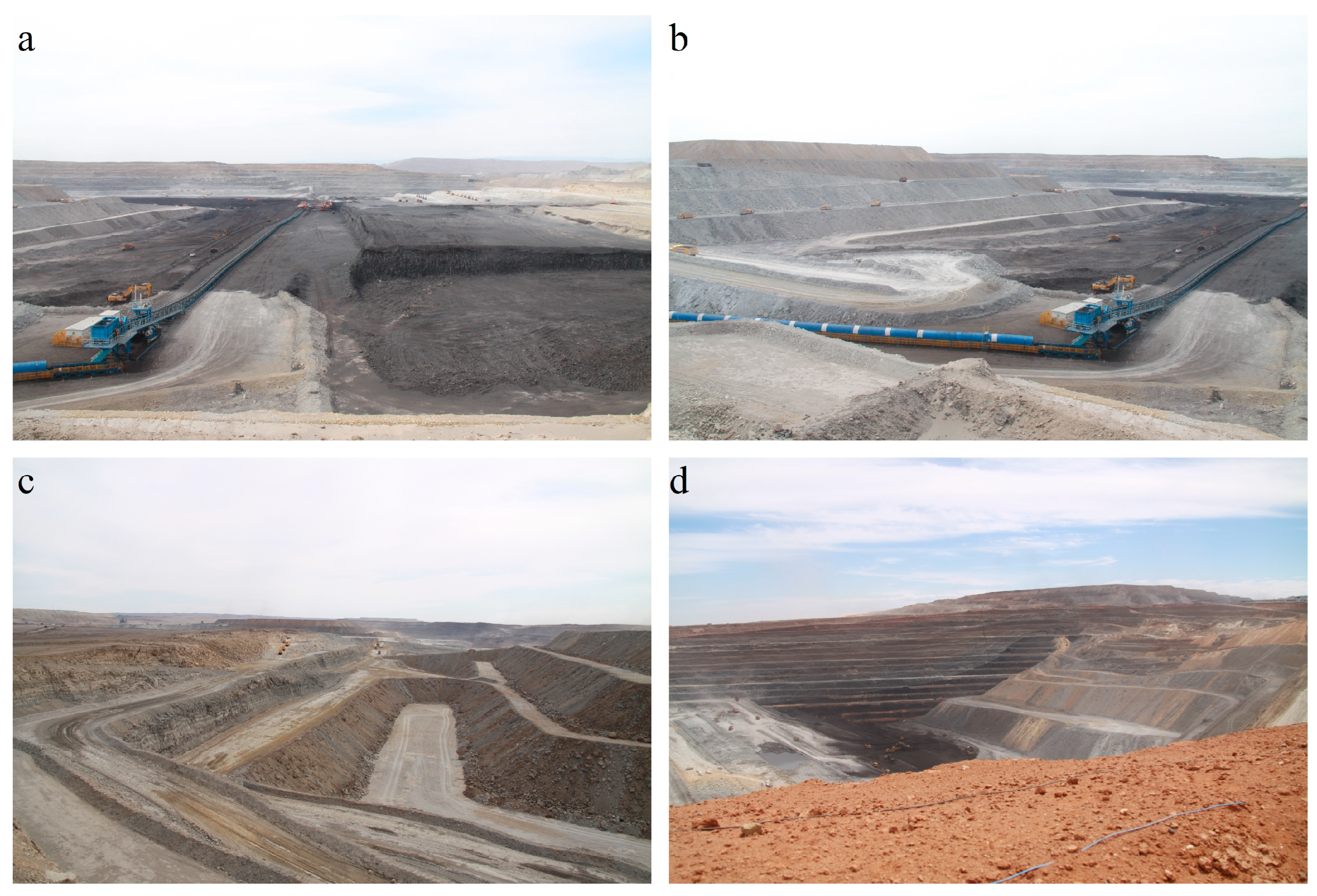
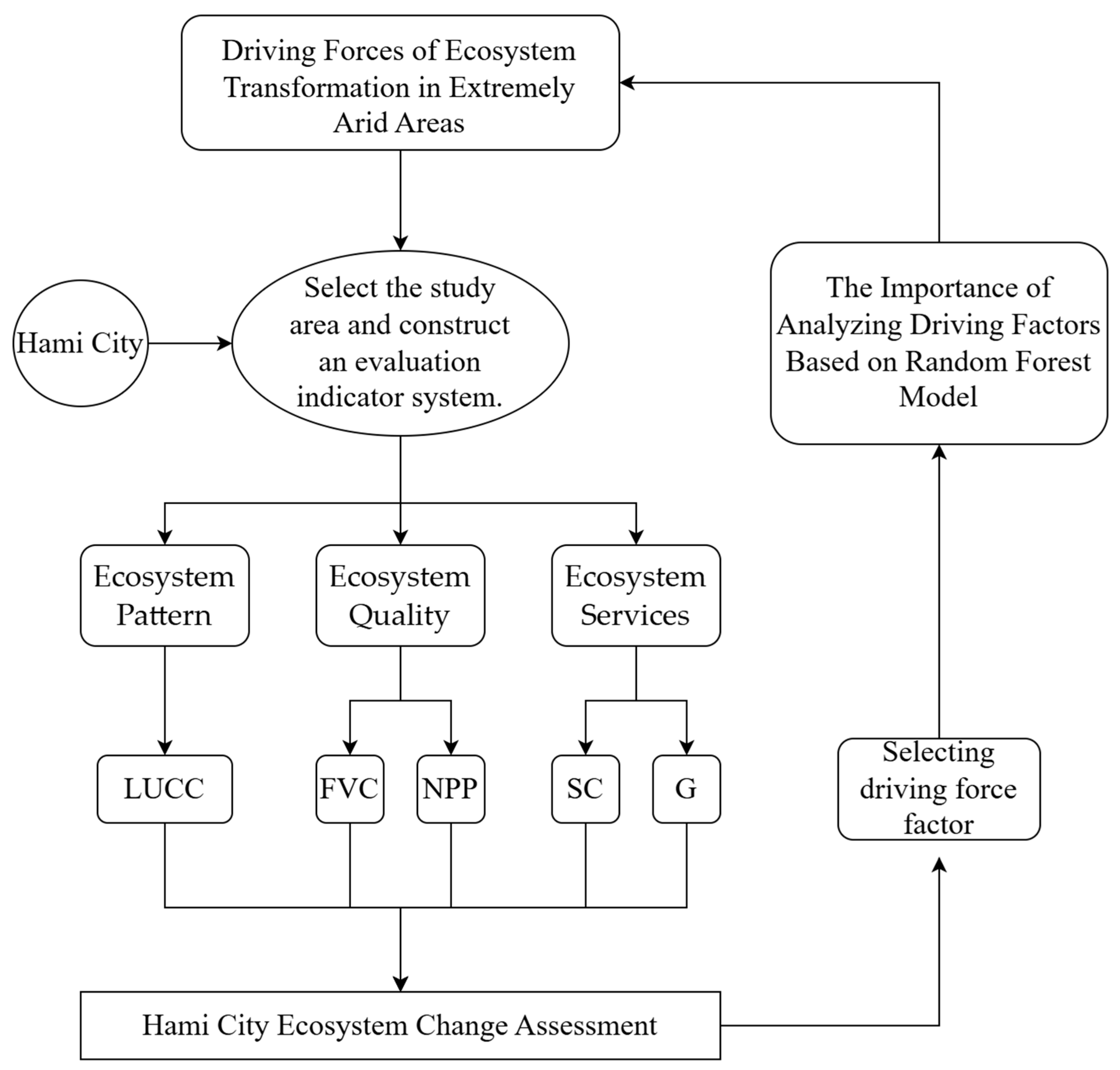
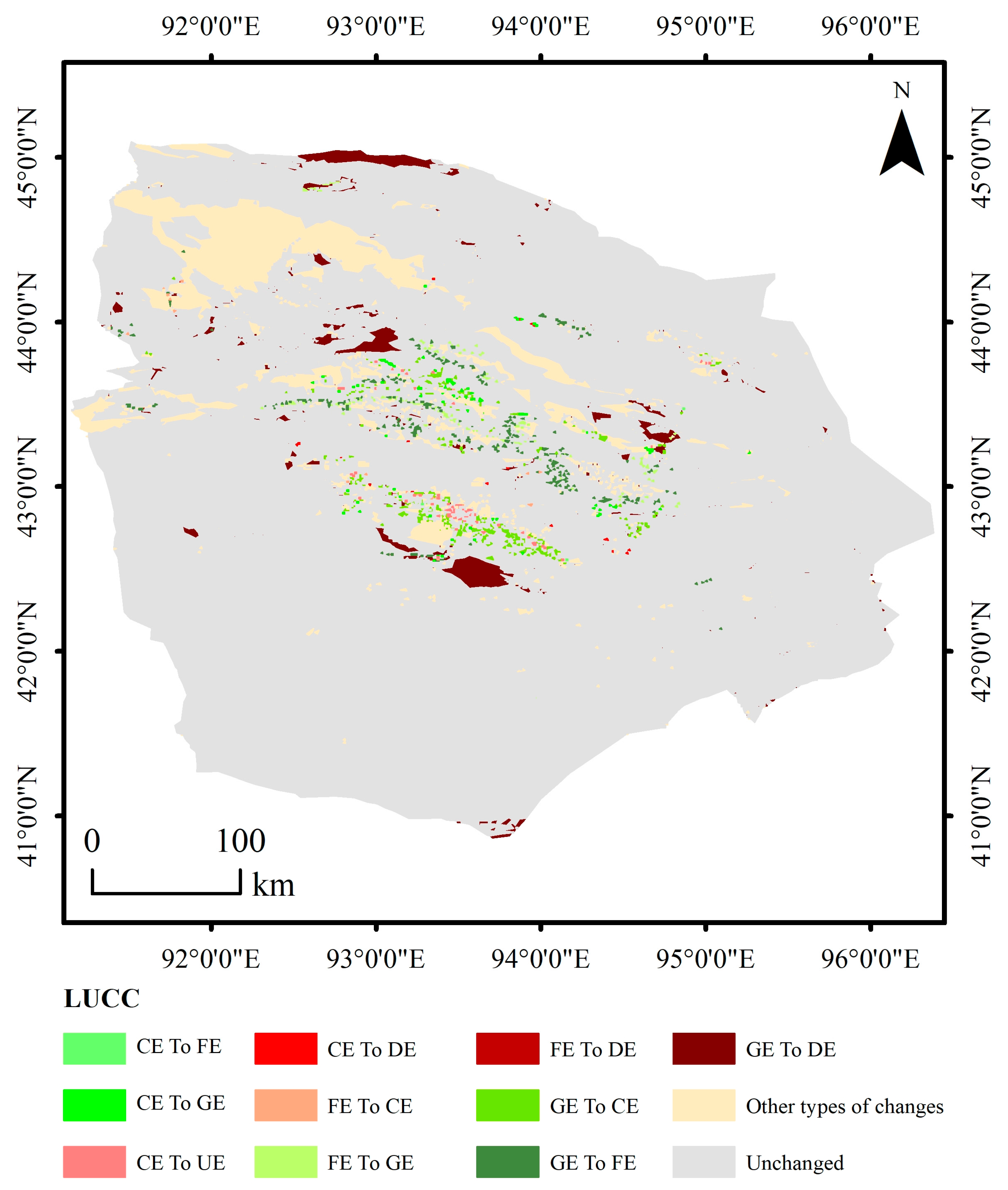
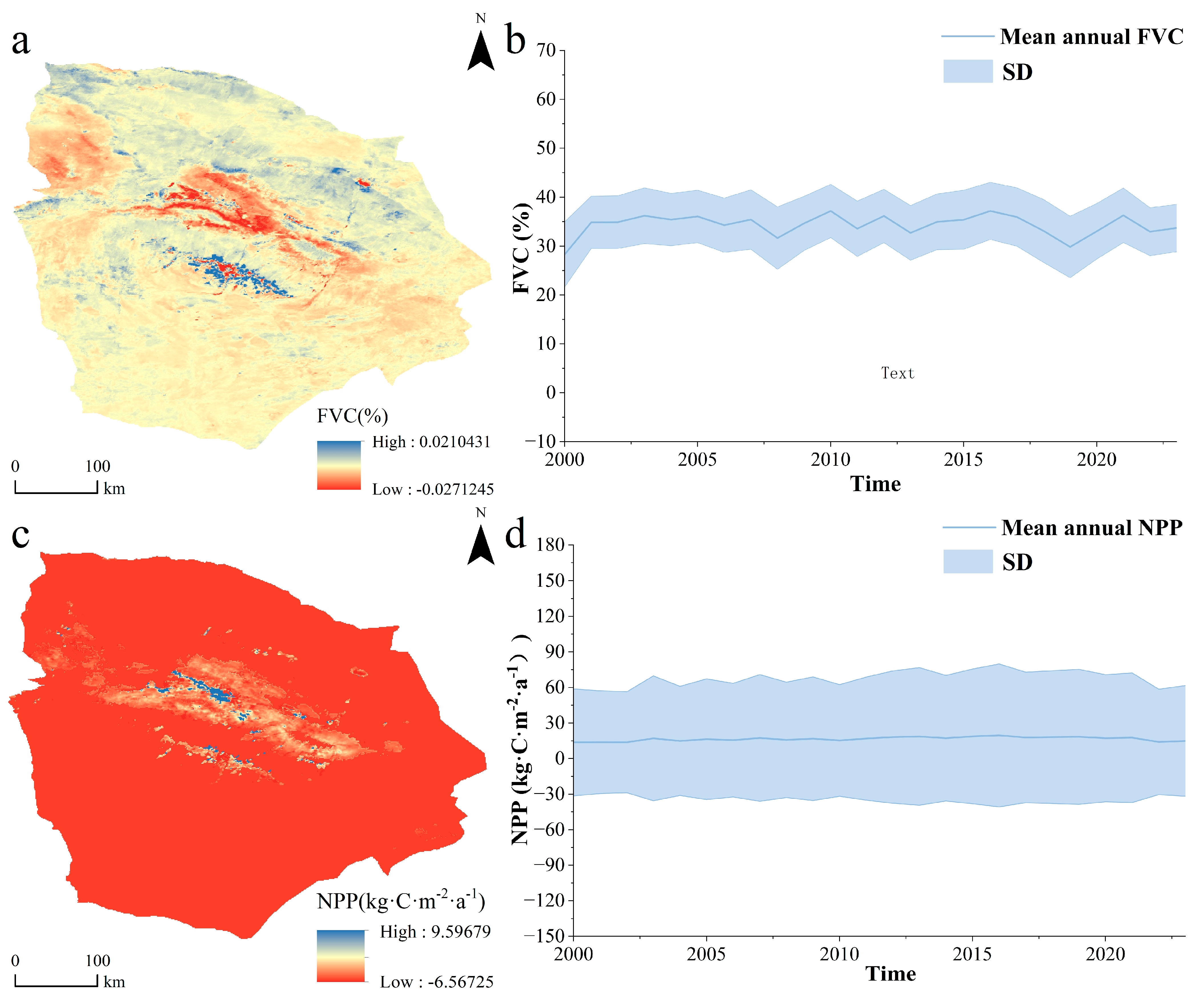
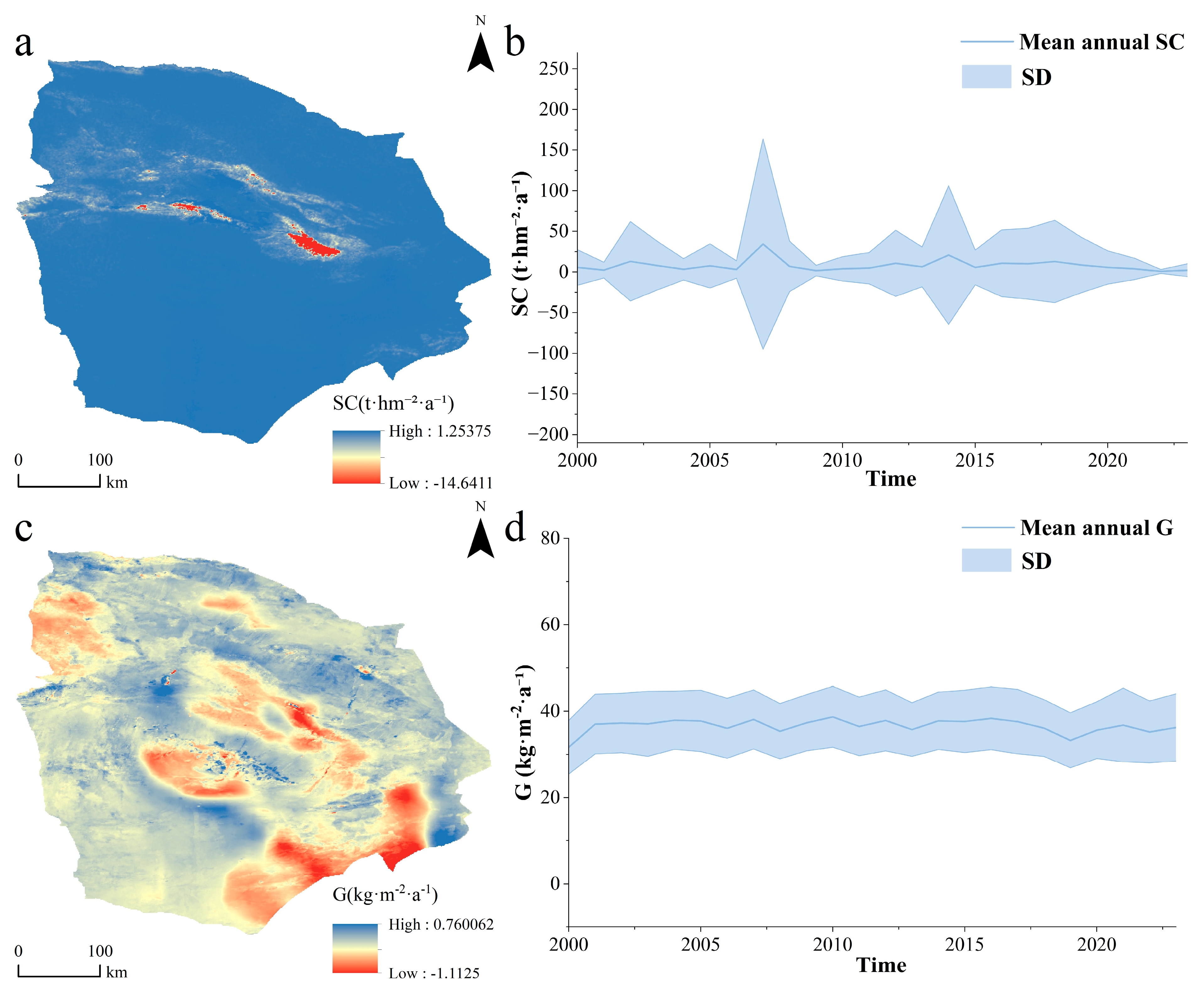
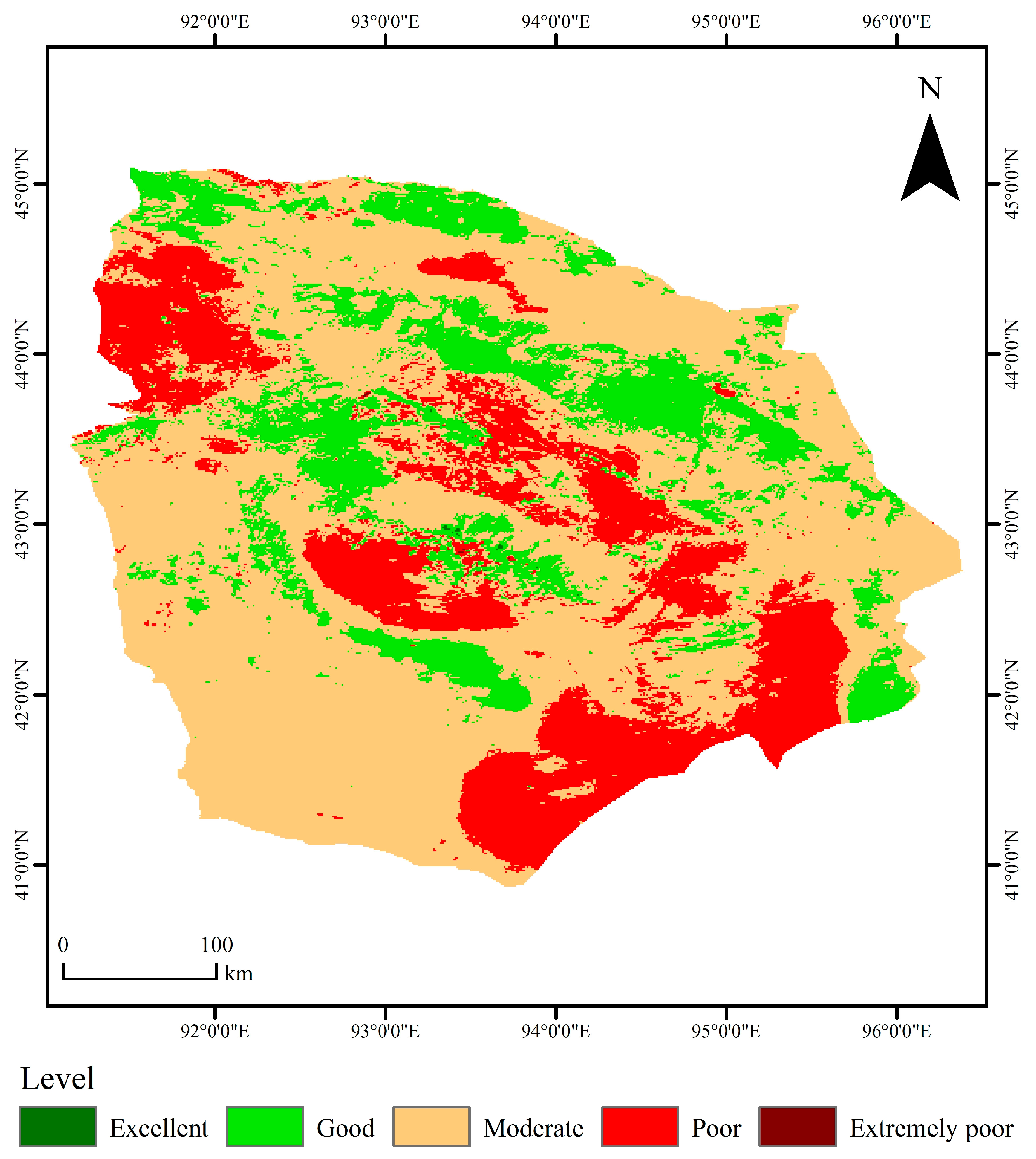


| Name | Source | Source Description | Notes |
|---|---|---|---|
| FVC [16] | https://lpdaac.usgs.gov/ (accessed on 11 November 2024) | The website provides terrestrial remote sensing data, tools, and resources. | The original spatial resolution was 250 m, and it was resampled to 1 km. |
| NPP [17] | https://lpdaac.usgs.gov/ (accessed on 12 November 2024) | The original spatial resolution was 500 m, and it was resampled to 1 km. | |
| Temperature | http://data.tpdc.ac.cn/ (accessed on 14 November 2024) | The website is China’s National Tibetan Plateau Data Center, offering meteorological, ecological, and hydrological datasets for the Tibetan Plateau and nearby regions. | The original spatial resolution was 1 km. |
| Precipitation | http://data.tpdc.ac.cn/ (accessed on 14 November 2024) | The original spatial resolution was 1 km. | |
| Soil moisture | http://data.tpdc.ac.cn/ (accessed on 14 November 2024) | The original spatial resolution was 0.5°, and it was resampled to 1 km. | |
| Wind speed | https://cds.climate.copernicus.eu/ (accessed on 15 November 2024) | The website is the Copernicus Climate Data Store, providing climate data and tools. | The original spatial resolution was 0.1°, and it was resampled to 1 km. Variables include east–west and north–south components at a 10 m height. |
| Snow cover | https://cds.climate.copernicus.eu/cdsapp#!/dataset/reanalysis-era5-land (accessed on 16 November 2024) | The website provides the ERA5-Land reanalysis dataset. | The original spatial resolution was 0.1°, and it was resampled to 1 km. |
| Evapotranspiration | https://disc.gsfc.nasa.gov/ (accessed on 17 November 2024) | The website is responsible for archiving and distributing Earth science data. | The original spatial resolution was 0.1°, and it was resampled to 1 km. |
| Calcium carbonate content | https://doi.org/10.4060/cc3823en (accessed on 19 November 2024) | The link is a resource from the Food and Agriculture Organization (FAO) knowledge base. | Data were resampled to a spatial resolution of 1 km. |
| Mining area | https://earth.google.com/ (accessed on 19 November 2024) | The website is Google Earth, offering global high-resolution satellite imagery and related features. | Converted into raster data with a 1 km resolution. |
| Population | https://landscan.ornl.gov/ (accessed on 21 November 2024) | The website provides global population distribution data. | The original spatial resolution was 1 km. |
| DEM | https://www.earthdata.nasa.gov/ (accessed on 23 November 2024) | The website provides Earth science data. | The original spatial resolution was 12.5 m, and it was resampled to 1 km. |
| GDP | https://www.stats.gov.cn/ (accessed on 3 April 2025) | The website is the official site of China’s National Bureau of Statistics, publishing statistical data and policies. | Converted into raster data with a 1 km resolution. |
| Organic matter content | Determined by the potassium dichromate external heating method | Lab-determined. | |
| Contents of sand, silt, and clay in the soil | Hydrometer method | Particle size classification was conducted according to the USDA soil texture classification system. |
| Category | Primary Indicator | Secondary Indicator |
|---|---|---|
| Ecosystem Pattern | Area of each ecosystem type | Proportion of ecosystem area |
| Area change rate of ecosystem types | ||
| Direction of ecosystem change | ||
| Area of each category | ||
| Ecosystem Quality | Fractional Vegetation Cover | Fractional Vegetation Cover |
| Net primary productivity | Vegetation net primary productivity | |
| Ecosystem Services | Soil Retention | Soil Retention |
| Windbreak and Sand Fixation | Soil Erosion Modulus | |
| Windbreak and Sand Fixation Amount |
| Factors | Name |
|---|---|
| TEM_RA | Annual mean rate of temperature change/% |
| PRE_RA | Annual mean rate of precipitation change/% |
| SM_RA | Annual mean rate of soil moisture change/% |
| ET_RA | Annual mean rate of total evapotranspiration change/% |
| MIN_RA | Annual mean rate of mining area change/% |
| GDP_GR | Annual mean GDP growth rate/% |
| POP_GR | Annual mean population growth rate/% |
| From/To | CE | FE | GE | WE | UE | DE |
|---|---|---|---|---|---|---|
| CE | 945.42 | 3.00 | 79.64 | 2.00 | 70.22 | 16.01 |
| FE | 22.00 | 131.44 | 305.37 | 0.00 | 2.00 | 16.07 |
| GE | 541.20 | 157.87 | 18,038.20 | 0.00 | 77.68 | 2946.02 |
| WE | 10.37 | 0.00 | 94.25 | 146.31 | 5.00 | 137.19 |
| UE | 8.61 | 0.00 | 5.64 | 0.00 | 102.22 | 34.99 |
| DE | 155.68 | 32.81 | 9367.87 | 72.22 | 240.22 | 103,386.38 |
| CE | FE | GE | WE | UE | DE | |
|---|---|---|---|---|---|---|
| Area in 2000/km2 | 1132.75 | 551.09 | 21,785.87 | 412.97 | 156.38 | 113,171.35 |
| Proportion/% | 0.83% | 0.40% | 15.88% | 0.30% | 0.11% | 82.48% |
| Area in 2023/km2 | 1745.16 | 361.63 | 27,894.34 | 232.55 | 549.27 | 106,415.83 |
| Proportion/% | 1.27% | 0.26% | 20.33% | 0.17% | 0.40% | 77.56% |
| Change in area/km2 | 612.41 | −189.46 | 6108.48 | −180.42 | 392.88 | −6755.52 |
| Proportion/% | 4.30% | 1.33% | 42.90% | 1.27% | 2.76% | 47.44% |
| Dynamics/% | 54.06% | 34.38% | 28.04% | 43.69% | 251.23% | 5.97% |
| Outflow area/km2 | 170.87 | 345.43 | 3722.76 | 246.81 | 49.23 | 9868.8 |
| Proportion/% | 1.19% | 2.40% | 25.85% | 1.71% | 0.34% | 68.51% |
| Inflow area/km2 | 737.85 | 193.67 | 9852.77 | 74.22 | 395.12 | 3150.18 |
| Proportion/% | 5.12% | 1.34% | 68.40% | 0.52% | 2.74% | 21.87% |
Disclaimer/Publisher’s Note: The statements, opinions and data contained in all publications are solely those of the individual author(s) and contributor(s) and not of MDPI and/or the editor(s). MDPI and/or the editor(s) disclaim responsibility for any injury to people or property resulting from any ideas, methods, instructions or products referred to in the content. |
© 2025 by the authors. Licensee MDPI, Basel, Switzerland. This article is an open access article distributed under the terms and conditions of the Creative Commons Attribution (CC BY) license (https://creativecommons.org/licenses/by/4.0/).
Share and Cite
Li, Z.; Wang, Y.; Wang, S.; Li, C. Driving Forces of Ecosystem Transformation in Extremely Arid Areas: Insights from Hami City in Xinjiang, China. Land 2025, 14, 2212. https://doi.org/10.3390/land14112212
Li Z, Wang Y, Wang S, Li C. Driving Forces of Ecosystem Transformation in Extremely Arid Areas: Insights from Hami City in Xinjiang, China. Land. 2025; 14(11):2212. https://doi.org/10.3390/land14112212
Chicago/Turabian StyleLi, Zhiwei, Younian Wang, Shuaiyu Wang, and Chengzhi Li. 2025. "Driving Forces of Ecosystem Transformation in Extremely Arid Areas: Insights from Hami City in Xinjiang, China" Land 14, no. 11: 2212. https://doi.org/10.3390/land14112212
APA StyleLi, Z., Wang, Y., Wang, S., & Li, C. (2025). Driving Forces of Ecosystem Transformation in Extremely Arid Areas: Insights from Hami City in Xinjiang, China. Land, 14(11), 2212. https://doi.org/10.3390/land14112212






